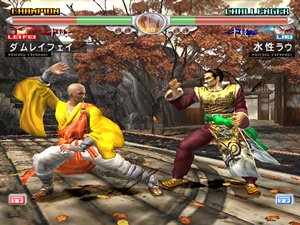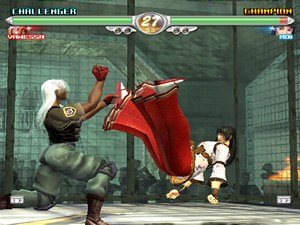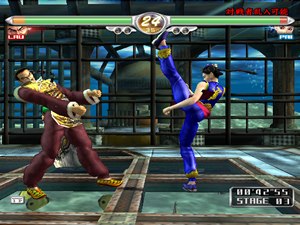Virtually unstoppable.
Ladies and gentleman, hell is now a crisp 15 degrees, fat ladies across the
land are singing like giddy school girls, pigs have sprouted wings, and Sega’s
venerable Virtua Fighter series has made its way to a Sony console in
the form of Virtua Fighter 4.
Developed
since the beginning by AM2, Virtua Fighter is a barebones series devoted
to the art of quick reflexes and keen fighting instinct. You won’t see fireballs
and the fighters can’t jump any higher than you or me. What you will see, however,
is swift and fluid movement, strings of interconnected actions that fly off
the fingers as fast as you can press the buttons. In the hands of someone who’s
spent time mastering the game, each of these lighting quick moves has a distinct
function. Throw in some near-arcade quality visuals and deep, engaging play
modes, and you’ve got a fighter that raises the bar for its competition, and
then some.
VF4 comes with 13 selectable characters out of the gate, two of whom
(Thai kickboxer Vanessa and Shaolin fighter Lei Fei) are new to the series.
Old VF stalwarts like the Jeet Kun Do bad boy Jacky and the flamboyant
pro-wrestler Wolf are back in full effect, each with a new set of moves tacked
on to the standard favorites.
Every character has received a face and body lift – they look a bit older
and grittier now. You get the sense that AM2 would have liked the characters
to have always looked like this, but it took until 2002 for technology to catch
up. As with past incarnations, each fighter adheres strictly to his or her own
martial art; everything from Ju-Jitsu to Jackie Chan-style Drunken Boxing are
represented faithfully.
One of the most tangible differences between Virtua Fighter 4 and its
predecessors is its vastly improved learning curve. This game is good for both
die-hards and button mashers alike. Gone is VF3‘s
irritating evade button, leaving just punch, kick, and guard. The system is
elegantly executed – easy moves flow into combos, essentially making the fight
only as difficult as you want it to be. Once you decide to dig your teeth in,
you’ll find that there’s an insane amount of depth in each character’s move
list. Vanessa, a Thai kick boxer, is easily one of the most complicated characters
ever seen in a fighting game. Put a newbie in control of her, however, and he
might manage to kick serious butt with a few well-placed high kicks.
To master VF4 is to master its controls, which can be described with
only one word: precise. Make that ‘painfully’ precise. You’ll likely spend hours
in the Training mode learning your fighter’s long combos, but once you do, you’ll
appreciate the game’s meticulousness.
Virtua Fighter is one of those rare fighting games that allows a well-seasoned
player to find his way out of any ass-whipping with a few perfectly timed button
presses. Reversals require that you not only analyze exactly what your opponent
is doing, but that you also hit two or three buttons in time to catch them in
the act (much harder and more rewarding than the somewhat easy timing in the
DOA series). Do this in less than half a second
or so, and you’ll make your opponent look silly. Entire matches can be won with
reversals, if you’re quick enough.
 In
In
order to learn VF4‘s more complicated moves, you’ll likely spend a lot
of time playing by yourself. Single player modes are typically an afterthought
in the home versions of arcade fighters. Namco, of course, has exploited this
weakness, creating some of the most enjoyable single player modes yet seen at
home (Soul Blade and Soul
Calibur, namely). In introducing the Virtua Fighter series to Sony
devotees, however, Sega has upped the ante.
Virtua Fighter 4‘s Kumite (pronounced ‘coom-i-tay’…remember Bloodsport?)
is easily one of the most enjoyable and complex single player modes ever seen
in a fighting game, not to mention a blast to play. Kumite is fundamentally
a rankings system. You create a character file and then go to blows with fighters
in ‘best of 5’ bouts. Work your way up through the ranks and you’ll not only
gain experience, but various prizes along the way that let you customize your
outfit.
The beauty of the system is that it effectively emulates the arcade experience
– computer-controlled players have their own unique profiles so you never know
who’s going to come next. And with each passing fight, the game tracks not only
your win-loss record, but an unbelievable amount of raw statistical data. Want
to know how often you connect with low punches? Just look it up. The game will
even give you advice on how to get better.
Other modes include a smart Training mode that essentially picks apart every
element of the VF fighting system, a funky A.I. game that allows you
to coach a computer player through the tournament, and the requisite Arcade
and Vs. Modes.
If you’ve had a chance to check out Virtua Fighter 4 in the arcade,
you probably told yourself that it’d be impossible for Sega to pull off such
stunning, Naomi 2-powered graphics on the PS2. Stand closer than five feet to
an average-sized TV and you’d be right. The lighting is less dramatic, special
effects have been toned down slightly, and the infamous PS2 anti-aliasing problem
is noticeable on the edges of some fighters and in the backgrounds.
For the most part, though, things look good for a home console. Consider Wolf’s
Arena stage. A dingy, rusted cage sits in the center of what looks like a hundred
or more fully-rendered thugs thirsty for a fight. Adding to the spectacle are
bright yellow spotlights that continually slice through the deep, emerald-green
background. A nice touch.
 Little
Little
graphical goodies are present in nearly every stage of the game. Light snow
falls continuously in Lion’s level, covering the ring with a foot of powder
that moves and melts during the fight. Throw a low kick in a heavily covered
area and snow will fly up in a cloud. Another favorite is Jacky’s skyscraper
stage – easily the best lighting I’ve ever seen in a fighting game. The fighters
are so drenched in spotlights and shadows that you might think they’re wearing
a different outfit. You won’t find any over-the-top, DOA3-ish
stages here. Virtua Fighter 4 doesn’t hit you over the head; it’s graphical
flair, like the game in general, is eloquently subtle.
With the obviously massive attention to detail Sega paid to this, their premier
fighting game, you’d think they’d have cleaned up the sound a bit. The sound
isn’t horrible, but considering the polished quality of the rest of the game,
simply average doesn’t cut it. Virtua Fighter vets will feel right at
home with the flat punches, the odd hand claps, and the good old fighter-jet
combo swishes, and they sound just like they did on the Saturn. Or maybe even
the 32x.
The music certainly isn’t terrible, but if you’ve played any other fighting
game made in the past 3 years, you’ve heard this stuff before: bad, treble-heavy
techno. Overall, VF4‘s sound isn’t quite bad enough to drag the game
down a whole lot, but it is bad enough to mention.
Despite these glitches, I can safely say Sega has nurtured this baby, well
aware that it holds the keys to their possible domination of a very important
genre on the PS2. It is not only the best fighter available for the system,
but pretty much the best console gamers have seen since Soul Calibur.

-
As close to the arcade as you can get
-
Perfect controls
-
Depth
-
Kumite!
-
Looks good
-
But not up close
-
Sound sucks











